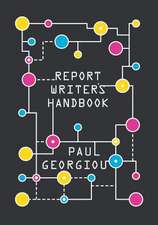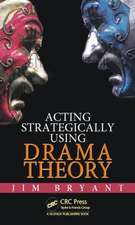Co-Opetition
Autor Adam M. Brandenburger, Ada Brandenberger, Brandenbergeren Limba Engleză Paperback – 30 noi 1997
Intel, Nintendo, American Express, NutraSweet, American Airlines, and dozens of other companies have been using the strategies of co-opetition to change the game of business to their benefit. Formulating strategies based on game theory, authors Brandenburger and Nalebuff created a book that's insightful and instructive for managers eager to move their companies into a new mind set.
Preț: 130.24 lei
Puncte Express: 195
Preț estimativ în valută:
23.05€ • 26.94$ • 20.01£
23.05€ • 26.94$ • 20.01£
Carte disponibilă
Livrare economică 29 ianuarie-12 februarie
Preluare comenzi: 021 569.72.76
Specificații
ISBN-13: 9780385479509
ISBN-10: 0385479506
Pagini: 304
Dimensiuni: 158 x 234 x 20 mm
Greutate: 0.42 kg
Editura: Crown Business
ISBN-10: 0385479506
Pagini: 304
Dimensiuni: 158 x 234 x 20 mm
Greutate: 0.42 kg
Editura: Crown Business
Extras
"Business is War." The traditional language of business certainly makes it sound that way: outsmarting the competition, capturing market share, making a killing, fighting brands, beating up suppliers, locking up customers.) Under business-as-war, there are the victors and the vanquished. The ultimate win-lose view of the world comes from author Gore Vidal:
It is not enough to succeed. Others must fail.
But the way people talk about business today, you wouldn't think so. You have to listen to customers, work with suppliers, create teams, establish strategic partnerships--even with competitors. That doesn't sound like war. Besides, there are few victors when business is conducted as war. The typical result of a price war is surrendered profits all around. Just look at the U.S. airline industry: it lost more money in the price wars of 1990-93 than it had previously made in all the time since Orville and Wilbur Wright. The antithesis to Gore Vidal's worldview comes from Bernard Baruch, a leading banker and financier for much of this century:
You don't have to blow out the other fellow's light to let your own shine.
Though less famous today than Gore Vidal, Baruch made a whole lot more money. More often than not, we'll follow Baruch's advice in this book.
In fact, most businesses succeed only if others also succeed. The demand for Intel chips increases when Microsoft creates more powerful software. Microsoft software becomes more valuable when Intel produces faster chips. It's mutual success rather than mutual destruction. It's win-win. The cold war is over and along with it the old assumptions about competition.
So,
"Business is Peace"?
That doesn't sound quite right, either. We still see battles with competitors over market share, fights with suppliers over cost, and conflicts with customers over price. And the success of Intel and Microsoft hasn't exactly helped Apple Computer. So if business isn't war and it isn't peace, what is it?
A New Mindset
Business is cooperation when it comes to creating a pie and competition when it comes to dividing it up.
In other words, business is War and Peace. But it's not Tolstoy--endless cycles of war followed by peace followed by war. It's simultaneously war and peace. As Ray Noorda, founder of the networking software company Novell, explains: "You have to compete and cooperate at the same time." The combination makes for a more dynamic relationship than the words "competition" and "cooperation" suggest individually. This is why we've adopted Noorda's word co-opetition, and made it the title of our book.
What's the manual for co-opetition? It's not Leadership Secrets of Attila the Hun. Nor is it Leadership Secrets of St. Francis of Assisi. You can compete without having to kill the opposition. If fighting to the death destroys the pie, there'll be nothing left to capture--that's lose-lose. By the same token, you can cooperate without having to ignore your self-interest. After all, it isn't smart to create a pie you can't capture--that's lose-win.
The goal is to do well for yourself. Sometimes that comes at the expense of others, sometimes not. In this book, we'll discuss business as a game, but not a game like sports, poker, or chess, which must be win-lose. In business, your success doesn't require others to fail--there can be multiple winners. Throughout the book, you'll see many examples of this. In the spirit of co-opetition, we'll present some cases where win-lose is the most effective approach and others where win-win is most effective. We'll discuss situations where defeating your competitors is the best course, and present other situations where the best plan benefits several players, including competitors.
Putting co-opetition into practice requires hardheaded thinking. It's not enough to be sensitized to the possibilities of cooperation and win-win strategies. You need a framework to think through the dollars-and-cents consequences of cooperation and of competition.
Game Theory
To find a way of bringing together competition and cooperation, we turn to game theory. Game theory has the potential to revolutionize the way people think about business. This is because the fundamental ideas of game theory are so powerful, and because business offers so many opportunities for applying them.
There has been a growing recognition that game theory is a crucial tool for understanding the modern business world. In 1994 three pioneers in game theory--John Nash, John Harsanyi, and Reinhart Selten--were awarded a Nobel Prize. At the same time, the Federal Communications Commission was using game theory to help it design a $7-billion auction of radio spectrum for personal communication services. (Naturally, the bidders used game theory too.) Even as we write, the leading management consulting firms are introducing game theory into their strategy practices.
The field of game theory dates back to the early days of World War II, when British naval forces playing cat and mouse with German submarines needed to understand the game better so that they could win it more often. They discovered that the right moves weren't the ones pilots and sea captains were making intuitively. By applying concepts later known as game theory, the British improved their hit rate enormously. Their success against submarines led them to apply game theory to many other war activities. Thus, game theory was proven in practical life-and-death situations before it was actually laid out on paper as a systematic theory.
The classic theoretical formulation came soon after, in 1944, when mathematical genius John von Neumann and economist Oskar Morgenstern published their book Theory of Games and Economic Behavior. This brilliant, but highly abstract, work was immediately heralded as one of the greatest scientific achievements of the century. It led to large numbers of technical papers in the fields of economics, politics, military strategy, law, computer science, and even evolutionary biology. In each of these fields, game theory has resulted in major discoveries. Now game theory is transforming the field of business strategy.
Game theory makes it possible to move beyond overly simple ideas of competition and cooperation to reach a vision of co-opetition more suited to the opportunities of our time. To many, this will come as a surprise. The image game theory often conjures up is business-as-war. That's to be expected, since the field was born during World War II and grew up during the Cold War. The mentality was one of winners and losers--the zero-sum game, even the zero-sum society. But that's only half the subject. Contemporary game theory applies just as well to positive-sum--or win-win--games. The real value of game theory for business comes when the full theory is put into practice: when game theory is applied to the interplay between competition and cooperation.
What are the essential characteristics of game theory as applied to business? What are its special virtues? How is it different from a host of other management tools?
What Game Theory Has to Offer
Game theory focuses directly on the most pressing issue of all: finding the right strategies and making the right decisions. There are many valuable books on how to create a management environment conducive to making the right decisions. There are also valuable books on how to build organizations effective at carrying out decisions once they're made. But there's still a great need for guidance in identifying the right strategy to begin with. This is what game theory provides. It goes right for the crux of things, showing you in strategic terms what is the best thing to do.
Game theory is particularly effective when there are many interdependent factors and no decision can be made in isolation from a host of other decisions. Business today is conducted in a world of bewildering complexity. Factors you might not even think to ask about can determine your success or failure. Even if you identify all the relevant factors, anything that changes one is likely to affect many others. Amid all this complexity, game theory breaks down the game into its key components. It helps you see what's going on and what to do about it.
Game theory is an especially valuable tool to share with others in your organization. The clear and explicit principles of game theory make it easier to explain the reasoning behind a proposed strategy. It gives you and your colleagues a common language for discussing alternatives. By letting others in on the process you've used to reach a strategic decision, game theory helps you build a consensus.
Such techniques for sharing strategic thinking are increasingly needed at all levels of business. Decision making is becoming more complex and more decentralized. Rapid changes in markets and technology require rapid, strategically informed responses. Hence, the number of people in a company who will benefit from applying game theory is growing greater all the time.
Game theory is an approach you can expand and build on. It's not a particular prescription suited to a particular moment in business history. It's not a rule of thumb that stops working when conditions change. It's a way of thinking that survives changing business environments.
In many cases, game theory can suggest options that otherwise might never have been considered. This is a consequence of game theory's systematic approach. By presenting a more complete picture of each business situation, game theory makes it possible to see aspects of the situation that would otherwise have been ignored. In these neglected aspects, some of the greatest opportunities for business strategy are to be found.
What You'll Find in This Book
We approach game theory mainly through real-life stories, involving characters and companies you'll recognize. These stories tell of businesses competing and cooperating, succeeding and failing, sometimes with surprising outcomes. Some are war stories, others are peace stories. In both cases, they are more than anecdotes. We use game theory to explain the successes and failures. Each story is a case study accompanied by a full analysis of the principles involved. We interweave the stories with theory, and summarize the lessons in the form of checklists. This way, our analysis becomes more than descriptive. It becomes prescriptive, too. When you understand why a strategy worked--or didn't--you can apply the lesson to other situations.
The numerous case studies have other functions as well. They're not just a device for making the subject more entertaining or for showing how our concepts work in practice. They serve as an ongoing test of our theories. We're skeptics, and we want you to be skeptical, too. We don't want you to take what we say on trust. Our goal is to give you enough evidence through case studies to accept or challenge our conclusions. After you've seen game theory applied to large numbers of cases, you'll discover its power, get a feel for how it works, and learn to apply it yourself.
Despite the current surge of interest in applying game theory to business, this is still a very new approach. Much of the terminology is new. In fact, some of the key terms were actually coined during the writing of this book. Even terms that seem familiar take on a new meaning in the context of game theory. Like any theory offering a new perspective, it requires some patience in the beginning. But if our explanations are successful, the new concepts will soon become so much a part of your thinking that you'll wonder how you ever managed without them.
How This Book Is Organized
Part I, consisting of three chapters, outlines the game of business. It introduces all the basic concepts and shows how they fit together. The present chapter is intended to serve as an orientation session, a kind of advance briefing on where this book will take you.
Chapter 2 describes all the players and analyzes the elements of competition and cooperation among them. To make this clear, we construct a map for the game of business. We call this the Value Net. It's a diagram that serves as a visual representation of the game of business. The Value Net locates all the various players relative to one another, and identifies the interdependencies among them. It's particularly useful for pointing out the ways a relationship between players can combine competition and cooperation.
Chapter 3 introduces game theory. We explain how this academic discipline applies to the real world of business. Using detailed examples, we discuss what happens when games are played out. In the process, we make game theory accessible by taking the essential principles and stating them in a simple and clear fashion that requires no mathematics or abstract theory.
Our account of game theory identifies five basic elements of any game: Players, Added values, Rules, Tactics, and Scope--PARTS, for short. These become our touchstones for the rest of the book. Along with the Value Net, they provide the central conceptual scheme for applying game theory to business.
Part II, the remainder of the book, consists of separate chapters on each of the five elements of a game. We describe each element in detail and what significance each has for your business. Archimedes said that given a proper lever, he could move the world. These are the five levers for moving the world of business.
Changing the Game
This is where the biggest payoff comes. We said business is different from other games because it allows more than one winner. But business is also different in another fundamental way: the game doesn't stand still. All the elements in the game of business are constantly changing; nothing is fixed. This is not just by chance. While football, poker, and chess have ultimate ruling bodies--the NFL or FIFA, Hoyle, and the Chess Federation--business doesn't. People are free to change the game of business to their benefit. And they do.
Why change the game? An old Chinese proverb explains: if you continue on the course you're headed, that's where you'll end up. Sometimes that's good, sometimes not. You can play the game extremely well, and still fare terribly. That's because you're playing the wrong game: you need to change it. Even a good game can be made into a better one. Real success comes from actively shaping the game you play--from making the game you want, not taking the game you find.
How do you change the game? You may well have been doing this instinctively. But game theory provides a systematic method. To change the game, you have to change one or more of the five elements: you change the PARTS. Each component we discuss is a powerful tool for transforming the game into a different one. This is where game theory finds its greatest opportunities: in changing the game. Changing not just the way you play, but the game you play.
It is not enough to succeed. Others must fail.
But the way people talk about business today, you wouldn't think so. You have to listen to customers, work with suppliers, create teams, establish strategic partnerships--even with competitors. That doesn't sound like war. Besides, there are few victors when business is conducted as war. The typical result of a price war is surrendered profits all around. Just look at the U.S. airline industry: it lost more money in the price wars of 1990-93 than it had previously made in all the time since Orville and Wilbur Wright. The antithesis to Gore Vidal's worldview comes from Bernard Baruch, a leading banker and financier for much of this century:
You don't have to blow out the other fellow's light to let your own shine.
Though less famous today than Gore Vidal, Baruch made a whole lot more money. More often than not, we'll follow Baruch's advice in this book.
In fact, most businesses succeed only if others also succeed. The demand for Intel chips increases when Microsoft creates more powerful software. Microsoft software becomes more valuable when Intel produces faster chips. It's mutual success rather than mutual destruction. It's win-win. The cold war is over and along with it the old assumptions about competition.
So,
"Business is Peace"?
That doesn't sound quite right, either. We still see battles with competitors over market share, fights with suppliers over cost, and conflicts with customers over price. And the success of Intel and Microsoft hasn't exactly helped Apple Computer. So if business isn't war and it isn't peace, what is it?
A New Mindset
Business is cooperation when it comes to creating a pie and competition when it comes to dividing it up.
In other words, business is War and Peace. But it's not Tolstoy--endless cycles of war followed by peace followed by war. It's simultaneously war and peace. As Ray Noorda, founder of the networking software company Novell, explains: "You have to compete and cooperate at the same time." The combination makes for a more dynamic relationship than the words "competition" and "cooperation" suggest individually. This is why we've adopted Noorda's word co-opetition, and made it the title of our book.
What's the manual for co-opetition? It's not Leadership Secrets of Attila the Hun. Nor is it Leadership Secrets of St. Francis of Assisi. You can compete without having to kill the opposition. If fighting to the death destroys the pie, there'll be nothing left to capture--that's lose-lose. By the same token, you can cooperate without having to ignore your self-interest. After all, it isn't smart to create a pie you can't capture--that's lose-win.
The goal is to do well for yourself. Sometimes that comes at the expense of others, sometimes not. In this book, we'll discuss business as a game, but not a game like sports, poker, or chess, which must be win-lose. In business, your success doesn't require others to fail--there can be multiple winners. Throughout the book, you'll see many examples of this. In the spirit of co-opetition, we'll present some cases where win-lose is the most effective approach and others where win-win is most effective. We'll discuss situations where defeating your competitors is the best course, and present other situations where the best plan benefits several players, including competitors.
Putting co-opetition into practice requires hardheaded thinking. It's not enough to be sensitized to the possibilities of cooperation and win-win strategies. You need a framework to think through the dollars-and-cents consequences of cooperation and of competition.
Game Theory
To find a way of bringing together competition and cooperation, we turn to game theory. Game theory has the potential to revolutionize the way people think about business. This is because the fundamental ideas of game theory are so powerful, and because business offers so many opportunities for applying them.
There has been a growing recognition that game theory is a crucial tool for understanding the modern business world. In 1994 three pioneers in game theory--John Nash, John Harsanyi, and Reinhart Selten--were awarded a Nobel Prize. At the same time, the Federal Communications Commission was using game theory to help it design a $7-billion auction of radio spectrum for personal communication services. (Naturally, the bidders used game theory too.) Even as we write, the leading management consulting firms are introducing game theory into their strategy practices.
The field of game theory dates back to the early days of World War II, when British naval forces playing cat and mouse with German submarines needed to understand the game better so that they could win it more often. They discovered that the right moves weren't the ones pilots and sea captains were making intuitively. By applying concepts later known as game theory, the British improved their hit rate enormously. Their success against submarines led them to apply game theory to many other war activities. Thus, game theory was proven in practical life-and-death situations before it was actually laid out on paper as a systematic theory.
The classic theoretical formulation came soon after, in 1944, when mathematical genius John von Neumann and economist Oskar Morgenstern published their book Theory of Games and Economic Behavior. This brilliant, but highly abstract, work was immediately heralded as one of the greatest scientific achievements of the century. It led to large numbers of technical papers in the fields of economics, politics, military strategy, law, computer science, and even evolutionary biology. In each of these fields, game theory has resulted in major discoveries. Now game theory is transforming the field of business strategy.
Game theory makes it possible to move beyond overly simple ideas of competition and cooperation to reach a vision of co-opetition more suited to the opportunities of our time. To many, this will come as a surprise. The image game theory often conjures up is business-as-war. That's to be expected, since the field was born during World War II and grew up during the Cold War. The mentality was one of winners and losers--the zero-sum game, even the zero-sum society. But that's only half the subject. Contemporary game theory applies just as well to positive-sum--or win-win--games. The real value of game theory for business comes when the full theory is put into practice: when game theory is applied to the interplay between competition and cooperation.
What are the essential characteristics of game theory as applied to business? What are its special virtues? How is it different from a host of other management tools?
What Game Theory Has to Offer
Game theory focuses directly on the most pressing issue of all: finding the right strategies and making the right decisions. There are many valuable books on how to create a management environment conducive to making the right decisions. There are also valuable books on how to build organizations effective at carrying out decisions once they're made. But there's still a great need for guidance in identifying the right strategy to begin with. This is what game theory provides. It goes right for the crux of things, showing you in strategic terms what is the best thing to do.
Game theory is particularly effective when there are many interdependent factors and no decision can be made in isolation from a host of other decisions. Business today is conducted in a world of bewildering complexity. Factors you might not even think to ask about can determine your success or failure. Even if you identify all the relevant factors, anything that changes one is likely to affect many others. Amid all this complexity, game theory breaks down the game into its key components. It helps you see what's going on and what to do about it.
Game theory is an especially valuable tool to share with others in your organization. The clear and explicit principles of game theory make it easier to explain the reasoning behind a proposed strategy. It gives you and your colleagues a common language for discussing alternatives. By letting others in on the process you've used to reach a strategic decision, game theory helps you build a consensus.
Such techniques for sharing strategic thinking are increasingly needed at all levels of business. Decision making is becoming more complex and more decentralized. Rapid changes in markets and technology require rapid, strategically informed responses. Hence, the number of people in a company who will benefit from applying game theory is growing greater all the time.
Game theory is an approach you can expand and build on. It's not a particular prescription suited to a particular moment in business history. It's not a rule of thumb that stops working when conditions change. It's a way of thinking that survives changing business environments.
In many cases, game theory can suggest options that otherwise might never have been considered. This is a consequence of game theory's systematic approach. By presenting a more complete picture of each business situation, game theory makes it possible to see aspects of the situation that would otherwise have been ignored. In these neglected aspects, some of the greatest opportunities for business strategy are to be found.
What You'll Find in This Book
We approach game theory mainly through real-life stories, involving characters and companies you'll recognize. These stories tell of businesses competing and cooperating, succeeding and failing, sometimes with surprising outcomes. Some are war stories, others are peace stories. In both cases, they are more than anecdotes. We use game theory to explain the successes and failures. Each story is a case study accompanied by a full analysis of the principles involved. We interweave the stories with theory, and summarize the lessons in the form of checklists. This way, our analysis becomes more than descriptive. It becomes prescriptive, too. When you understand why a strategy worked--or didn't--you can apply the lesson to other situations.
The numerous case studies have other functions as well. They're not just a device for making the subject more entertaining or for showing how our concepts work in practice. They serve as an ongoing test of our theories. We're skeptics, and we want you to be skeptical, too. We don't want you to take what we say on trust. Our goal is to give you enough evidence through case studies to accept or challenge our conclusions. After you've seen game theory applied to large numbers of cases, you'll discover its power, get a feel for how it works, and learn to apply it yourself.
Despite the current surge of interest in applying game theory to business, this is still a very new approach. Much of the terminology is new. In fact, some of the key terms were actually coined during the writing of this book. Even terms that seem familiar take on a new meaning in the context of game theory. Like any theory offering a new perspective, it requires some patience in the beginning. But if our explanations are successful, the new concepts will soon become so much a part of your thinking that you'll wonder how you ever managed without them.
How This Book Is Organized
Part I, consisting of three chapters, outlines the game of business. It introduces all the basic concepts and shows how they fit together. The present chapter is intended to serve as an orientation session, a kind of advance briefing on where this book will take you.
Chapter 2 describes all the players and analyzes the elements of competition and cooperation among them. To make this clear, we construct a map for the game of business. We call this the Value Net. It's a diagram that serves as a visual representation of the game of business. The Value Net locates all the various players relative to one another, and identifies the interdependencies among them. It's particularly useful for pointing out the ways a relationship between players can combine competition and cooperation.
Chapter 3 introduces game theory. We explain how this academic discipline applies to the real world of business. Using detailed examples, we discuss what happens when games are played out. In the process, we make game theory accessible by taking the essential principles and stating them in a simple and clear fashion that requires no mathematics or abstract theory.
Our account of game theory identifies five basic elements of any game: Players, Added values, Rules, Tactics, and Scope--PARTS, for short. These become our touchstones for the rest of the book. Along with the Value Net, they provide the central conceptual scheme for applying game theory to business.
Part II, the remainder of the book, consists of separate chapters on each of the five elements of a game. We describe each element in detail and what significance each has for your business. Archimedes said that given a proper lever, he could move the world. These are the five levers for moving the world of business.
Changing the Game
This is where the biggest payoff comes. We said business is different from other games because it allows more than one winner. But business is also different in another fundamental way: the game doesn't stand still. All the elements in the game of business are constantly changing; nothing is fixed. This is not just by chance. While football, poker, and chess have ultimate ruling bodies--the NFL or FIFA, Hoyle, and the Chess Federation--business doesn't. People are free to change the game of business to their benefit. And they do.
Why change the game? An old Chinese proverb explains: if you continue on the course you're headed, that's where you'll end up. Sometimes that's good, sometimes not. You can play the game extremely well, and still fare terribly. That's because you're playing the wrong game: you need to change it. Even a good game can be made into a better one. Real success comes from actively shaping the game you play--from making the game you want, not taking the game you find.
How do you change the game? You may well have been doing this instinctively. But game theory provides a systematic method. To change the game, you have to change one or more of the five elements: you change the PARTS. Each component we discuss is a powerful tool for transforming the game into a different one. This is where game theory finds its greatest opportunities: in changing the game. Changing not just the way you play, but the game you play.
Descriere
"Co-Opetition" is a new business strategy that combines the advantages of both competition and cooperation. Intel, Nintendo, American Express, and dozens of other companies have been using co-opetition not only to win but to make it possible for their industry as a whole to grow.
Notă biografică
Adam M. Brandenburger














